“Rust Monster: The Relentless Devourer of Metal”
“Lurking in shadows and hungry for steel, the Rust Monster’s antennae detect metal with deadly precision, leaving armor crumbling and weapons useless in its corrosive wake.”
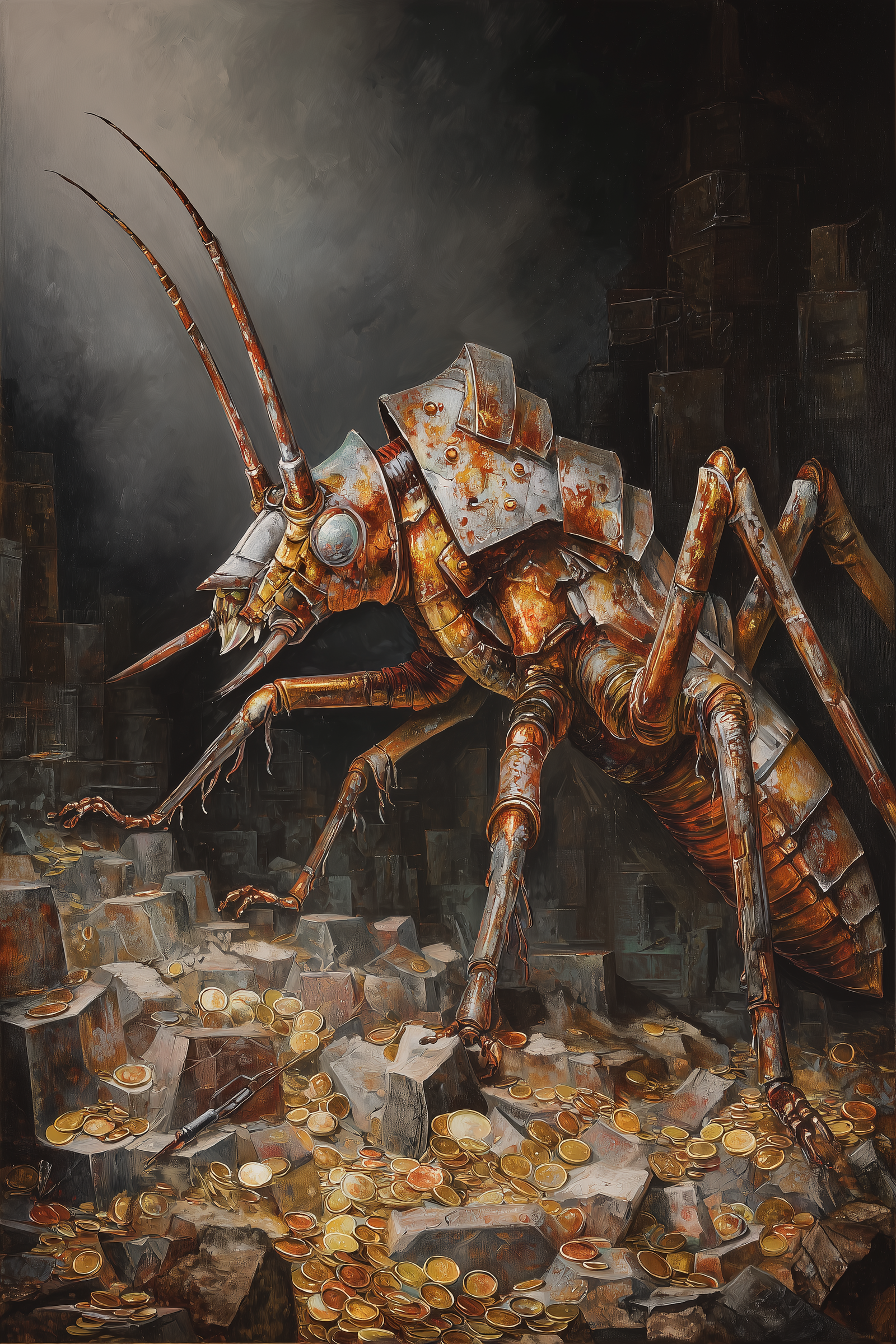
A grotesque, insectoid predator roughly the size of a large dog, the Rust Monster is sheathed in segmented, iron-brown carapace plates streaked with metallic corrosion. Its long, jointed antennae twitch constantly, detecting even the faintest trace of metal, while its jagged mandibles glint with a subtle acidic sheen. Its many clawed legs give it a creeping, deliberate gait, evoking an unnerving blend of patience and menace.
Behaviour:
Rust Monsters are methodical and deliberate rather than openly aggressive. They examine objects with unsettling curiosity before feeding and move with relentless focus toward any source of metal. Solitary by nature, they may become fiercely competitive if multiple individuals encounter the same hoard of equipment.
Habitat:
Favoring dark, damp environments, Rust Monsters are commonly found in abandoned mines, subterranean caverns, and forgotten ruins. They maintain and patrol a defined territory, roaming in search of metal to consume.
Modus Operandi:
These creatures hunt by sensing metal through their sensitive antennae, silently approaching and using their corrosive mandibles to destroy armor, weapons, and tools. They typically avoid direct conflict with living creatures, instead neutralizing threats by rendering their equipment useless.
Motivation:
Compelled by a relentless instinct to feed on metal, Rust Monsters are driven not by malice but by necessity. Their singular purpose is the consumption and corrosion of metal, making them a silent but devastating hazard to adventurers who rely on steel and iron.
Rust Monster 5e 2024
Rust Monster 5e
Rust Monster, Pathfinder
Rust Monster
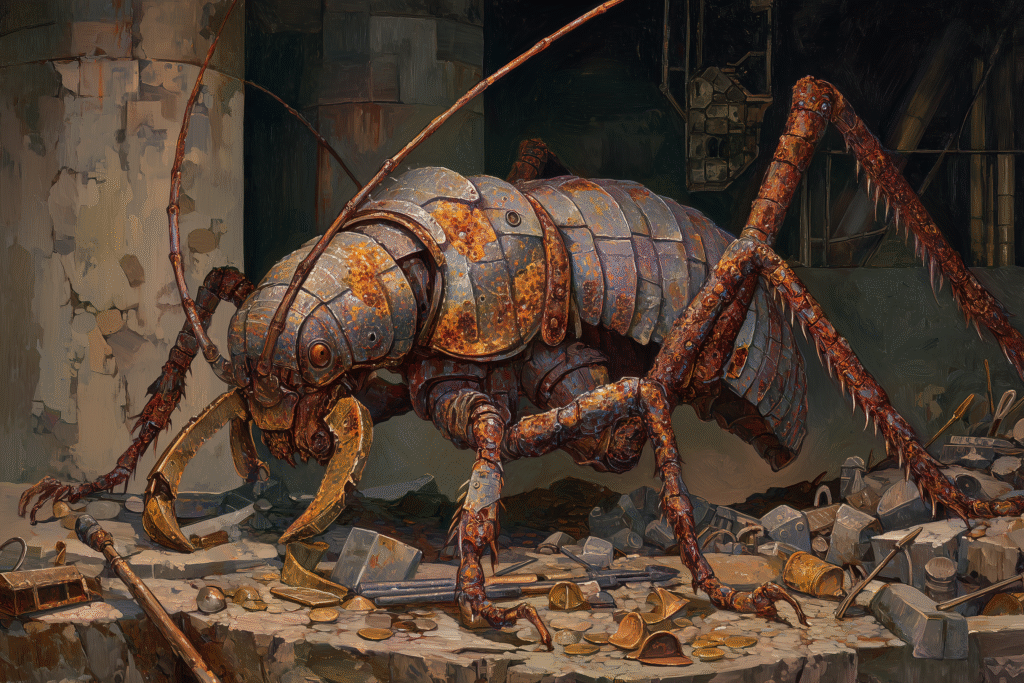
Medium monstrosity, unaligned
Armor Class: 14 (natural armor)
Hit Points: 52 (8d8 + 16)
Speed: 30 ft., climb 20 ft.
| STR | DEX | CON | INT | WIS | CHA |
|---|---|---|---|---|---|
| 14 (+2) | 16 (+3) | 14 (+2) | 4 (−3) | 12 (+1) | 6 (−2) |
Saving Throws: Dex +5, Wis +3
Skills: Perception +3, Stealth +5
Damage Resistances: Poison; Bludgeoning, Piercing, and Slashing from Nonmagical Weapons
Damage Immunities: Acid
Condition Immunities: Charmed, Frightened
Senses: Darkvision 60 ft., Tremorsense 30 ft., passive Perception 13
Languages: —
Challenge Rating: 2 (450 XP)
Traits
Metal Sense. It can sense the presence of metal within 60 feet of it. This includes weapons, armor, coins, and metallic tools.
Corrosive Touch. Any nonmagical weapon or metal armor the Rust Monster touches begins to corrode. Metal armor loses 1 point of AC (to a minimum of 10) after 1 minute of contact, and weapons lose 1d4 damage per successful hit until repaired. Magical metal items are immune.
Keen Smell. The Rust Monster has advantage on Wisdom (Perception) checks that rely on smell.
Spider Climb. The Rust Monster can climb difficult surfaces, including upside down on ceilings, without needing to make an ability check.
Actions
Multiattack. It makes two attacks with its mandibles.
Mandibles. Melee Weapon Attack: +4 to hit, reach 5 ft., one target. Hit: 7 (1d8 + 3) bludgeoning damage plus 5 (1d10) corrosion damage to metal objects it is carrying or wearing.
Rust Spray (Recharge 5–6). The Rust Monster releases a spray of acidic mist in a 15-foot cone. Each creature and unattended metal object in that area must make a DC 13 Dexterity saving throw. On a failed save, creatures take 10 (3d6) acid damage and metal objects take 10 (3d6) corrosion damage. Half damage on a successful save.
Reactions
Defensive Curl. When hit by a melee attack, the Rust Monster can curl into a protective ball, gaining +2 AC until the start of its next turn.
Legendary Actions
The Rust Monster can take 1 legendary action, choosing from the options below. Only one legendary action can be used at a time and only at the end of another creature’s turn.
- Creep: The Rust Monster moves up to its speed without provoking opportunity attacks.
- Mandible Snap: Makes one mandible attack.
Combat Tactics
Rust Monsters avoid direct conflict with creatures that have nonmetal weapons, preferring to disable opponents by corroding their gear first. In combat, they use stealth and terrain to approach targets, employ Rust Spray to weaken groups, and retreat to hide when heavily threatened. They favor ambushes in metal-rich environments like armories, abandoned mines, or treasure vaults.
Rust Monster
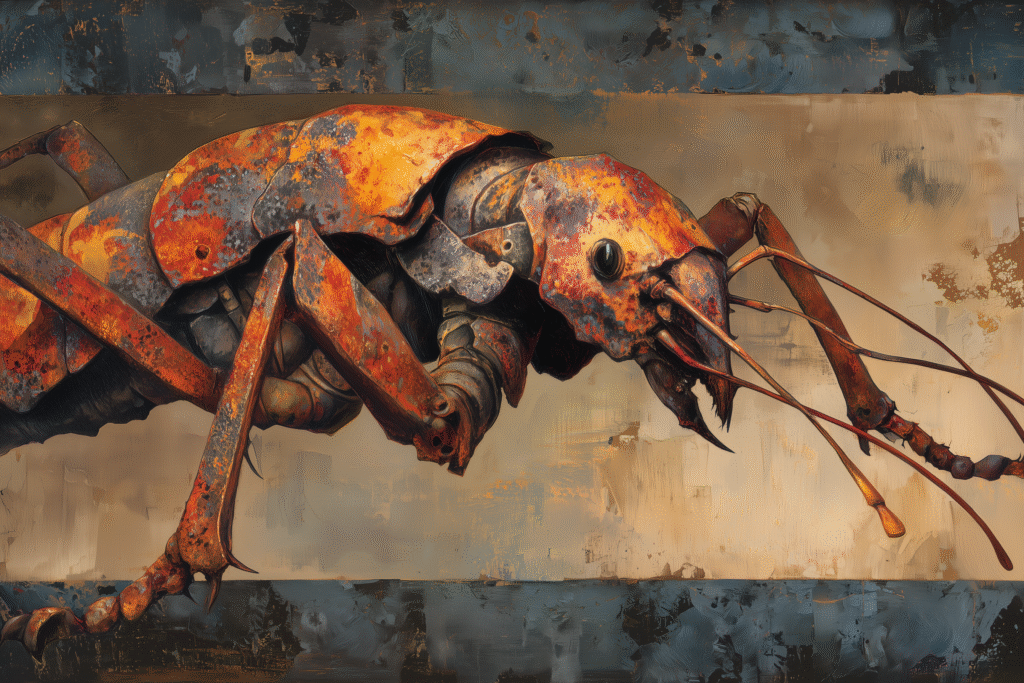
Medium beast, unaligned
Armor Class 14 (natural armor)
Hit Points 27 (5d8 + 5); Wound Threshold 7
Speed 40 ft.
| STR | DEX | CON | INT | WIS | CHA |
|---|---|---|---|---|---|
| 13 (+1) | 12 (+1) | 12 (+1) | 2 (-4) | 13 (+1) | 6 (-2) |
Senses darkvision 60 ft., passive Perception 11
Languages —
Challenge 1/2 (100 XP)
SPECIAL TRAITS
- Iron Scent. The rust monster can pinpoint, by scent, the location of ferrous metal within 30 feet of it.
- Rust Metal. Any nonmagical weapon made of metal that hits the rust monster corrodes. After dealing damage, the weapon takes a permanent and cumulative -1 penalty to damage rolls. If its penalty drops to -5, the weapon is destroyed. Nonmagical ammunition made of metal that hits the rust monster is destroyed after dealing damage.
ABOUT
Rust monsters don’t form colonies, but particularly large and ferocious specimens, with a faster rate of egg-laying, are still referred to as matriarchs. Aggressive and clever, a matriarch can represent a significant threat on her own if she has the chance to build a nest in an area rich in oxidable minerals.
The rust monster is an extraordinary arthropod of significant size at maturity, known for its appetite for metal and other minerals that it consumes oxidized, if not completely rusted. Since their food is primarily found in cities and mines, the creatures like to roam around these areas, causing a lot of damage. Others wander through the caverns of the Netherworld, searching for their next morsel, whether alone or in a group.
Rust Monster Nests
A female rust monster will bring back as much metal as possible to her nest, where she’ll lay about twenty eggs. Her larvae will grow while gorging themselves on rusted metal, before taking their first molt, after which they’ll be left to their own devices. They’ll reach adult size after a few years.
Miners and mine owners are well aware of the scourge a growing population of rust monsters represents, so they’re quick to employ adventurers at the first sign of these creatures, to find their nest and exterminate them. This attitude of trying to annihilate a species is a problem in the eyes of those who are close to druidic traditions.
In their opinion, rust monsters have a role to play and a balance must be found.
SPECIAL OPTION
When using this option, oxidation is not an absolute and limitless phenomenon. It’s a chemical process that can transform certain metals and stones, but not all. For example, gold and mithral don’t oxidize. On the other hand, iron, silver, copper, and bronze are very vulnerable to oxidation and, therefore, appetizing to rust monsters. Bauxite—a red soil that is plentiful in some desert lands—is an example of a type of naturally oxidized dirt, making it an ideal terrain for a population of rust monsters.
Section 15: Copyright Notice
The Creatures Rulebook for the Fateforge Role-Playing Game Copyright © 2021 Studio Agate.
Rust Monster
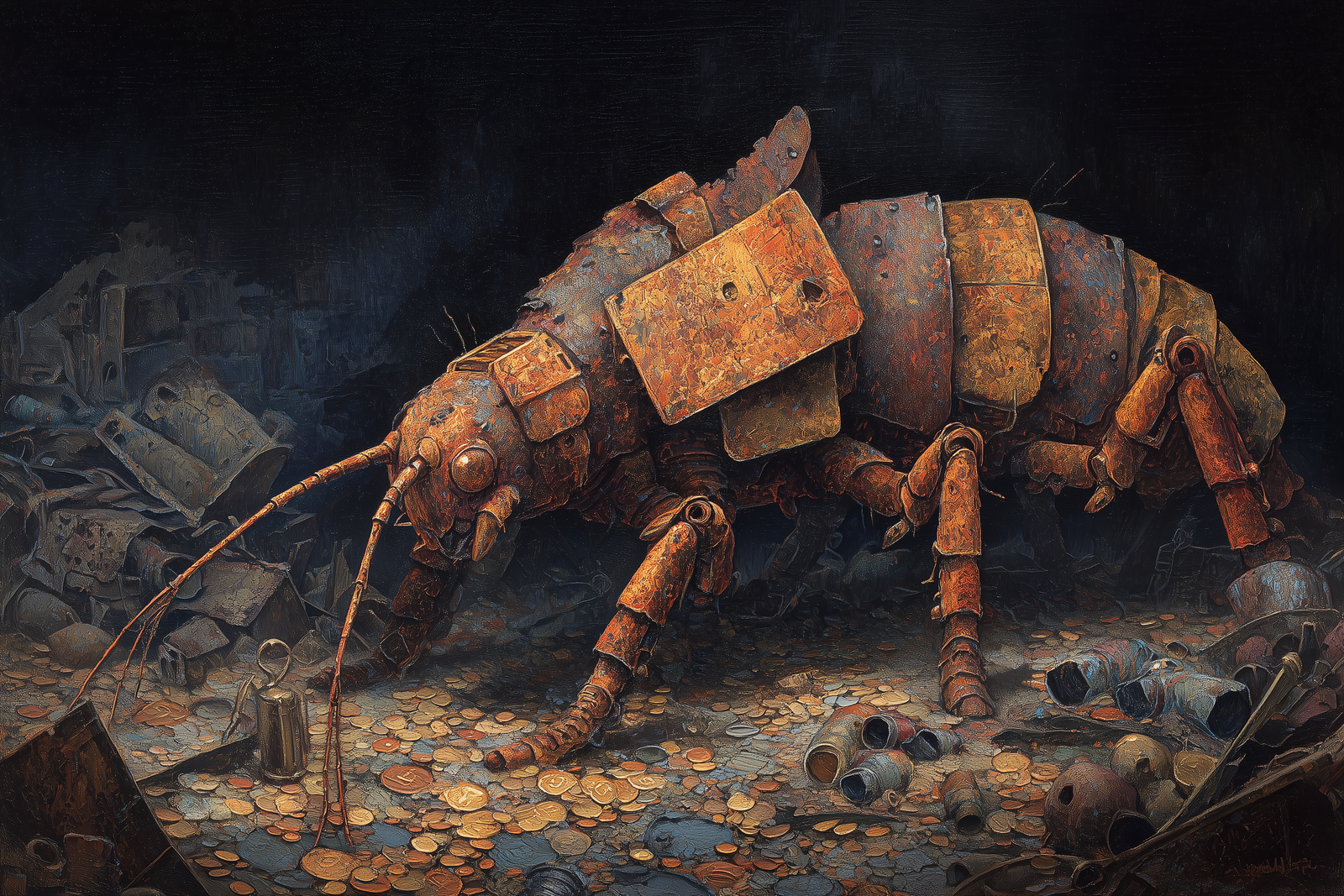
This insectile monster has four legs, a strange propeller-shaped protrusion at the end of its tail, and two long, feathery antennae.
Of all the terrifying beasts an explorer might encounter underground, only the rust monster targets that which the average adventurer values most: his treasure.
Typically 5 feet long and weighing almost 200 pounds, the lobster-like rust monster would be frightening enough even without the alien feeding process that gives it its name. They consume metal objects, preferring iron and ferrous alloys like steel but devouring even mithral, adamantine, and enchanted metals with equal ease. Any metal touched by the rust monster’s delicate antennae or armored hide corrodes and falls to dust within seconds, making the beast a major threat to subterranean adventurers and those dwarven miners who must defend their forges and compete for ore.
Though they have no innate tendency toward violence, their insatiable hunger leads them to charge anything they come across that bears even trace amounts of metal, and any resistance is met with unthinking savagery. It’s not unheard of for rust monsters in metal-poor areas to track escaped victims for days using their scent metal ability, provided the victims retain intact metal objects. Fortunately, it’s often possible to escape a rust monster’s attentions by throwing it a dense metal object like a shield and running in the opposite direction. Those who frequent areas infested with these creatures quickly learn to keep a few stone or wooden weapons close at hand.
Rust Monster CR 3
XP 800
N Medium aberration
Init +3; Senses darkvision 60 ft., scent metals 90 ft.; Perception +12
DEFENSE
AC 18, touch 13, flat-footed 15 (+3 Dex, +5 natural)
hp 27 (5d8+5)
Fort +2, Ref +4, Will +5
OFFENSE
Speed 40 ft., climb 10 ft.
Melee bite +6 (1d3), antennae +6 touch (rust)
STATISTICS
Str 10, Dex 17, Con 13, Int 2, Wis 13, Cha 8
Base Atk +3; CMB +3; CMD 16 (20 vs. trip)
Feats Ability Focus (rust), Skill Focus (Perception), Weapon Finesse
Skills Climb +8, Perception +12
SPECIAL ABILITIES
Rust (Su)
A rust monster‘s antennae are a primary touch attack that causes any metal object they touch to swiftly rust and corrode. The object touched takes half its maximum hp in damage and gains the broken condition—a second hit destroys the item. A rust monster never provokes attacks of opportunity by attempting to strike a weapon with its antennae. Against creatures made of metal, a rust monster‘s antennae deal 3d6+5 points of damage. An attended object, any magic object, or a metal creature can attempt a DC 15 Reflex save to negate this effect. The save DC is Constitution-based.
Scent Metals (Ex)
This ability functions much the same as the scent ability, except that the range is 90 feet and the rust monster can only use it to sense metal objects (including creatures wearing or carrying metal objects).
ECOLOGY
Environment any underground
Organization solitary, pair, or nest (3–10)
Treasure incidental (no metal treasure)
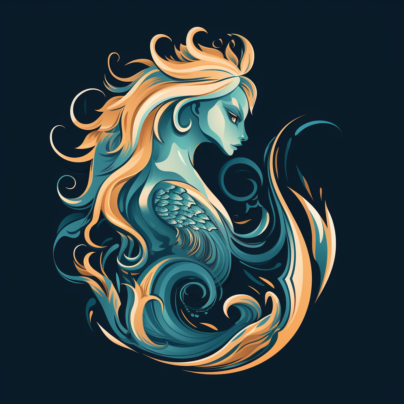
 Buy me a coffee
Buy me a coffee